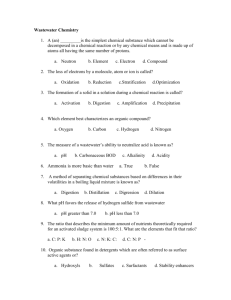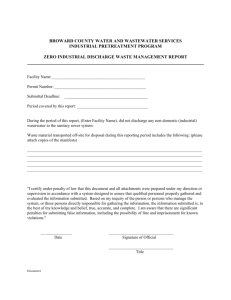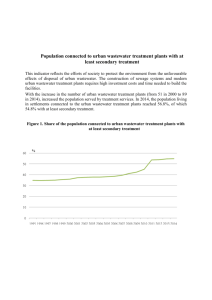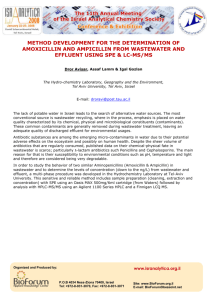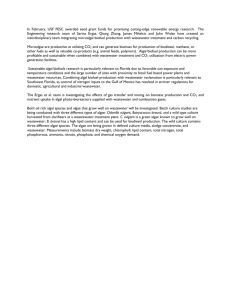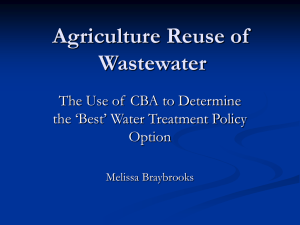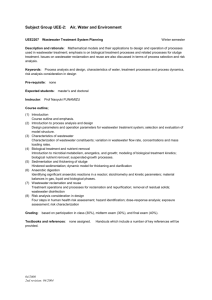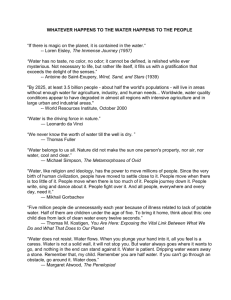- IREP - International Islamic University Malaysia
advertisement
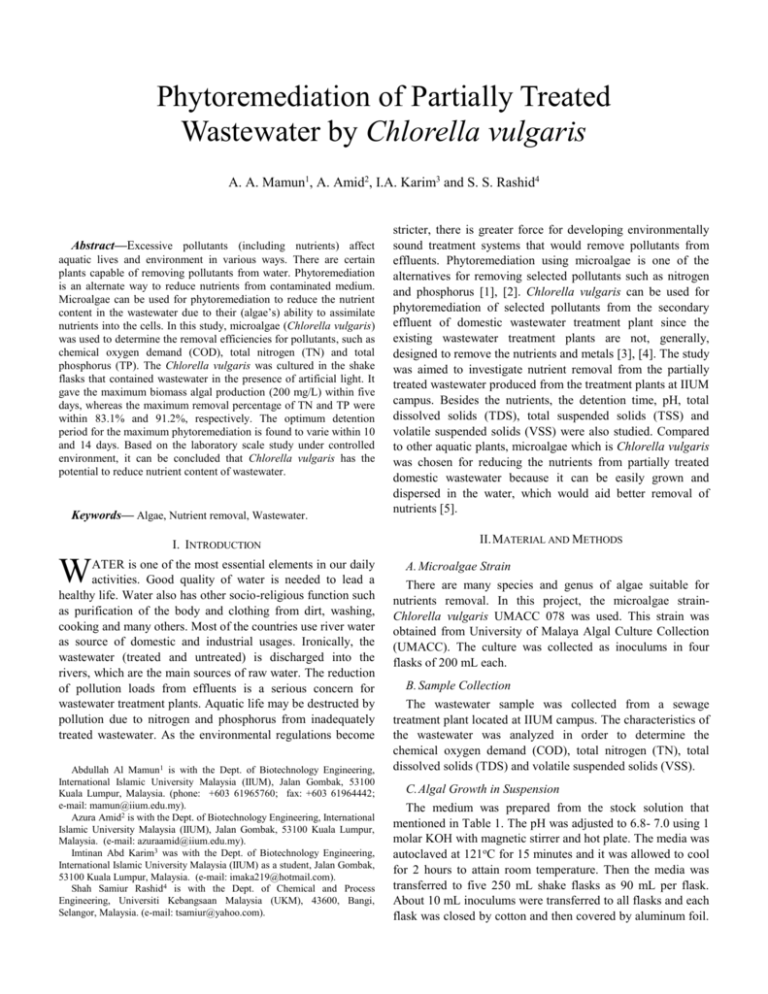
Phytoremediation of Partially Treated Wastewater by Chlorella vulgaris A. A. Mamun1, A. Amid2, I.A. Karim3 and S. S. Rashid4 Abstract—Excessive pollutants (including nutrients) affect aquatic lives and environment in various ways. There are certain plants capable of removing pollutants from water. Phytoremediation is an alternate way to reduce nutrients from contaminated medium. Microalgae can be used for phytoremediation to reduce the nutrient content in the wastewater due to their (algae’s) ability to assimilate nutrients into the cells. In this study, microalgae (Chlorella vulgaris) was used to determine the removal efficiencies for pollutants, such as chemical oxygen demand (COD), total nitrogen (TN) and total phosphorus (TP). The Chlorella vulgaris was cultured in the shake flasks that contained wastewater in the presence of artificial light. It gave the maximum biomass algal production (200 mg/L) within five days, whereas the maximum removal percentage of TN and TP were within 83.1% and 91.2%, respectively. The optimum detention period for the maximum phytoremediation is found to varie within 10 and 14 days. Based on the laboratory scale study under controlled environment, it can be concluded that Chlorella vulgaris has the potential to reduce nutrient content of wastewater. Keywords— Algae, Nutrient removal, Wastewater. stricter, there is greater force for developing environmentally sound treatment systems that would remove pollutants from effluents. Phytoremediation using microalgae is one of the alternatives for removing selected pollutants such as nitrogen and phosphorus [1], [2]. Chlorella vulgaris can be used for phytoremediation of selected pollutants from the secondary effluent of domestic wastewater treatment plant since the existing wastewater treatment plants are not, generally, designed to remove the nutrients and metals [3], [4]. The study was aimed to investigate nutrient removal from the partially treated wastewater produced from the treatment plants at IIUM campus. Besides the nutrients, the detention time, pH, total dissolved solids (TDS), total suspended solids (TSS) and volatile suspended solids (VSS) were also studied. Compared to other aquatic plants, microalgae which is Chlorella vulgaris was chosen for reducing the nutrients from partially treated domestic wastewater because it can be easily grown and dispersed in the water, which would aid better removal of nutrients [5]. I. INTRODUCTION II. MATERIAL AND METHODS ATER is one of the most essential elements in our daily activities. Good quality of water is needed to lead a healthy life. Water also has other socio-religious function such as purification of the body and clothing from dirt, washing, cooking and many others. Most of the countries use river water as source of domestic and industrial usages. Ironically, the wastewater (treated and untreated) is discharged into the rivers, which are the main sources of raw water. The reduction of pollution loads from effluents is a serious concern for wastewater treatment plants. Aquatic life may be destructed by pollution due to nitrogen and phosphorus from inadequately treated wastewater. As the environmental regulations become A. Microalgae Strain There are many species and genus of algae suitable for nutrients removal. In this project, the microalgae strainChlorella vulgaris UMACC 078 was used. This strain was obtained from University of Malaya Algal Culture Collection (UMACC). The culture was collected as inoculums in four flasks of 200 mL each. W Abdullah Al Mamun1 is with the Dept. of Biotechnology Engineering, International Islamic University Malaysia (IIUM), Jalan Gombak, 53100 Kuala Lumpur, Malaysia. (phone: +603 61965760; fax: +603 61964442; e-mail: mamun@iium.edu.my). Azura Amid2 is with the Dept. of Biotechnology Engineering, International Islamic University Malaysia (IIUM), Jalan Gombak, 53100 Kuala Lumpur, Malaysia. (e-mail: azuraamid@iium.edu.my). Imtinan Abd Karim3 was with the Dept. of Biotechnology Engineering, International Islamic University Malaysia (IIUM) as a student, Jalan Gombak, 53100 Kuala Lumpur, Malaysia. (e-mail: imaka219@hotmail.com). Shah Samiur Rashid4 is with the Dept. of Chemical and Process Engineering, Universiti Kebangsaan Malaysia (UKM), 43600, Bangi, Selangor, Malaysia. (e-mail: tsamiur@yahoo.com). B. Sample Collection The wastewater sample was collected from a sewage treatment plant located at IIUM campus. The characteristics of the wastewater was analyzed in order to determine the chemical oxygen demand (COD), total nitrogen (TN), total dissolved solids (TDS) and volatile suspended solids (VSS). C. Algal Growth in Suspension The medium was prepared from the stock solution that mentioned in Table 1. The pH was adjusted to 6.8- 7.0 using 1 molar KOH with magnetic stirrer and hot plate. The media was autoclaved at 121oC for 15 minutes and it was allowed to cool for 2 hours to attain room temperature. Then the media was transferred to five 250 mL shake flasks as 90 mL per flask. About 10 mL inoculums were transferred to all flasks and each flask was closed by cotton and then covered by aluminum foil. This step was done within laminar flow hood. All the 250 mL flasks were inserted to shaker at 110 rpm for 1 week at room temperature in 12 hours light and 12 hours dark cycles. E. Laboratory Tests Total nitrogen (TN), total phosphorus (TP), chemical oxygen demand (COD) and volatile suspended solids (VSS) were analyzed according to the standard methods [6]. TABLE I COMPOSITION OF BOLD’S BASAL MEDIUM No Item Per 400 mL 1 NaNO3 10.0 g 2 MgSO4.7H2O 3.0 g 3 K2HPO4 4.0 g 4 KH2PO4 6.0 g 5 CaCl2 1.0 g 6 NaCl 1.0 g Trace metal solution (1 Liter) 7 ZnSO4 8.82 g MoO3 0.71 g Co(NO3)2.6H2O 0.49 g CuSO4.5H2O 1.57 g Autoclave to dissolve Per 100 mL 8 H3BO3 1.14 g EDTA-KOH solution 9 10 EDTA.Na2 5.0 g KOH 3.1 g FeSO4.7H2O 4.98 g Concentrated HCl 1.0 mL III. RESULT AND DISCUSSIONS A. Effluent Characteristics Partially treated effluent was brown to pale yellow, quite turbid and smelly. The characterization was done and presented in Table 2 which showed that the wastewater contained high levels of pollutants. The COD and TN concentrations exceeded the permitted effluent standard regulated by the Department of Environment (DOE) Malaysia. It was clear that additional treatment would be required to improve the quality of the effluent before it is discharged into the receiving waters or rivers. B. Nutrient Removal Nutrient removal as indicated by measurement of TN and TP from the wastewater during algal culture was high in the experiment. The effluent without algae which was assigned as control always gave lower removal values of TN and TP than the inoculated treatments throughout the period of the test. However, both of them gave similar removal pattern which was decreasing with the increment of time. TABLE II PARTIALLY TREATED WASTEWATER QUALITY COMPARED WITH MALAYSIAN EFFLUENT DISCHARGE STANDARDS Medium Stock solution 1-6 10.0 mL Stock solution 7-10 1.0 mL The distilled water was added to make up 1 liter and the pH was adjusted with 1M KOH to 6.8. The medium was autoclaved. No 1 D.Transfer to Wastewater The dry concentration (mg/L) of the Chlorella vulgaris obtained was determined by filtration of a culture liquors sample through GC paper and oven drying at 103 – 105°C for about 1 hour. Based on the dry weight result, Chlorella vulgaris inocula for succeeding test were adjusted to 100 mg/L by addition of an appropriate amount of wastewater. The 14 shake flasks (250 mL) were used containing partially treated wastewater (50 mL) inoculated with Chlorella vulgaris of 100 mg/L concentration. Another 14 shake flasks (250 mL) containing wastewater without algae was used as control. The study was conducted under batch culture process in the laboratory under fluorescent tube light for 12 hours per day. All samples were incubated at 110 rpm continuously up to 14 days. Sample was collected and analyzed everyday for first 10 days and every 2 days up to 14 days for total nitrogen (TN), total phosphorus (TP), chemical oxygen demand (COD), and volatile suspended solids (VSS). 2 3 Treatment Parameter Chemical Oxygen Demand (COD), mg/L Total Nitrogen (TN), mg/L Total Phosphorus (TP), mg/L Effluent Standard Comment Before After A B 90 20 50 100 Fulfilled 64 14.2 35 35 Fulfilled 10.8 1.5 Not Specified Not Specified C. Total Nitrogen (TN) Table 2 shows the experimental result for TN of the studied effluent. The amount of TN in the treated wastewater decreased significantly with time. The initial concentration of TN in control was 64 mg/L. It was found from the results that the concentration of TN decreased significantly with the time length of culture. Initial value of TN was 64.0 mg/L and decreased to 14.2 mg/L. Maximum removal occurred on the day 12 and onwards which was 77.8%. This result is quite similar to the study done by Sreesai and Pakpain [7]. They found that the maximum removal occurred on day 8 which was 88%. The difference of removal occurred because they did the study under real - sunlight while this study used the fluorescent light which gave different intensity. Day 1 2 3 4 5 6 7 8 9 10 12 14 This occurred mainly because of the nutrients and other growth limiting factors. The other limiting factors that might be considered include the concentrations or form of carbon TABLE III source available in the culture medium and other organic REMOVAL OF POLLUTANTS WITH TIME growth promoters. In this experiment, there were no additions of any carbon sources, phosphorus or trace elements to the TN TP COD treated wastewater to enhance or optimize Chlorella vulgaris Conc. Removal Conc. Removal Conc. Removal growth. The results obtained was similar stated in the previous study by Bich et al. [13], who reported that the VSS (mg/L) (%) (mg/L) (%) (mg/L) (%) concentration was within 277-390 mg/L at 4 to 5 days. It is 64.0 0.0 10.8 0.0 90 0.0 possible that algal biomass might have increased if mineral 59.2 7.5 8.6 11.9 86 4.2 nutrients and some trace elements had been added. 55.9 14.5 7.9 36.7 80 11.1 49.2 40.6 38.7 34.7 30.4 20.8 14.5 14.2 30.1 36.6 39.5 45.8 52.5 67.5 77.3 77.8 6.9 6.0 5.0 4.0 3.3 2.3 1.9 1.5 35.9 40.7 53.7 62.9 69.4 78.7 82.4 86.1 72 58 54 47 40 35 30 20 19.0 35.3 40.0 47.8 55.6 61.1 66.3 77.7 14.2 77.8 1.5 86.1 20 77.8 D.Total Phosphorous (TP) Table 3 shows the variation of effluent quality and percent removal with time. The initial value of TP was 10.8 mg/L, which was same as control. The final concentration was 1.5 mg/L. The trend of changes in TP was similar to the changes in TN. The maximum removal of TP also occurred at day 12 onwards which was 86.1%. This result better than other studies such as by Gonzalez [8], who found that the microalgae Chlorella vulgaris removed 50% of TP from wastewater. Likewise Weerawattanaphong [9], who cultured Chlorella vulgaris in poultry wastewater with a retention time of 8 days, found that maximum TP removal was 77%. One of the recent studies done by Sreesai and Pakpain [7] found that the TP removal was 68% under natural sunlight. E. Chemical Oxygen Demand (COD) The initial concentration of COD was 90 mg/L, while the final concentration was 20 mg/L. The maximum value of percent removal of COD occurred at day 14th day, which was 77.8%. The result agreed with other studies such as Aziz and Ng [10], who found that maximum percent removal for COD was about 82% using an activated algal process to treat wastewater. F. Biomass Production The volatile suspended solid (VSS) was monitored in order to know the biomass produced by Chlorella vulgaris during the study period. The results obtained for VSS is given in Table 3. Figure shows that the maximum concentration of VSS or biomass was 200 mg/L at day 5. After that, the concentration of algal biomass started to decrease and reached the lowest concentration at day 12. Fig. 1 Graph of VSS production for control and sample For the control the initial concentration of VSS was 100 mg/L and it increasing until day 4. After day 4 the concentration was decreased until day 12 and remained constant up to day 14 which was 40 mg/L (Figure 1). G.Treatment Quality The results obtained from the experiment were compared with the effluent quality standard set by the DOE Malaysia (Table 2). The location of this wastewater treatment plant required to follow Standard A, as the plant is located upstream of water intake. COD and TN concentration after the phytoremediation was below the effluent discharge limits. There was no limit set for TN. Promising high removal of pollutants indicated that the algal system might be feasible as a tertiary treatment processes to remove nutrients and other dissolved pollutants from partially treated wastewater from university campus. IV. CONCLUSION Based on the laboratory analysis done, it can be concluded that the Chlorella vulgaris can be used to remove nutrients from the wastewater. However their performance varied depending on the culture environment. Growth of Chlorella vulgaris was influenced by growth factor such as sufficient light and nutrients and its maximum biomass was obtained on the fifth day of the treatment. The maximum algal biomass is 200 mg/L. This biomass can be further used for various purposes such as protein for animal feed, soil conditioner and raw materials for energy as well as produce the fertilizer. At the peak of Chlorella vulgaris growth on the fifth day of the batch culture TP and COD removal efficiencies were 40.7% and 35.3% respectively. For TN the high percent removal occurred at day 7 onward which is around 45.877.8%. The effluent water qualities met a Malaysia standard requirement. Both TN and TP removal in partially treated wastewater was governed by the growth of Chlorella vulgaris in combination with other microorganisms. Therefore, Chlorella vulgaris is suitable for reduction of nutrient content in the wastewater in higher considerable amount and can help to achieve the effluent quality directive by the Malaysian government environment protection agency and it is a good option of biological tertiary treatment of domestic wastewater treatment plant as well. ACKNOWLEDGMENT The authors would like to gratefully acknowledge the assistance rendered by the staffs of the department of biotechnology engineering at IIUM. The microalgae strain Chlorella vulgaris UMACC 078 was obtained from the University of Malaya Algal Culture Collection (UMACC). REFERENCES G. Laliberte, D. Proulx, N. De Pauw and J. La Noue. “Algal technology in wastewater treatment”. In: LC Rai, JP Gaur and CJ Soeder (eds.) Algae and Water Pollution. Adv. Limnol. 42, pp. 283- 302, 1994. [2] W. J. Oswald, “Micro-algae and wastewater treatment”. In: Borowitzka, M.A., Borowitzka, L.J. (Eds.), Micro-algal Biotechnology. Cambridge University Press, Cambridge, UK, pp. 305–328, 1988. [3] P. Pavasant, R. Apiratikul, V. Sungkhum, P. Suthiparinyanont, S. Wattanachira, T. F. Marhaba. “Biosorption of Cu2+, Cd2+, Pb2+, and Zn2+ using dried marine green macroalga Caulerpa lentillifera”. Bioresour. Technol. 97, pp. 2321-2329, 2006. [4] N. Yoshida, K. Ishii, T. Okuno, & K. Tanaka. “Purification and Characterization of Cadmium-Binding Protein from Unicelluar Algae Chlorella sorokinian”. Current Microbiology, 52, 6, pp. 460–463, 2006. [5] A. K. Sen, M. Bhattacharya. “Studies of uptake and toxic effects of Ni on Salvinia natans”. Water, Air and Soil Pollution, 78, pp. 141-152, 1994. [6] APHA. “Standard methods for the examination of water and wastewater, 17th edition”, American Public Health Association, Washington, DC, 1989. [7] S. Sreesai, & P. Pakpain, Nutrient recycling by Chlorella vulgaris from the Bangkok city, Thailand. ScienceAsia, 33, pp. 293-299, 2007. [8] L. E. Gonzalez, R. O. Canizares & S. Baena, “Effeciency of ammonia and phosphorus removal from a colombian agroindustrial wastewater by the microalgae Chlorella vulgaris and Scenedesmus dimorphus”. Bioresource Technology, 60, pp. 259-262, 1997. [9] W. Weerawattanaphong, “Nutrients reduction fromS c i e n c eAs i a 299 poultry wastewater by green algae: Chlorella vulgaris” (M.Sc. thesis in Environmental Technology). Bangkok Faculty of Graduated studies, Mahidol University, Thailand, 1998. [10] M. A. Aziz, & W. J. Ng, “Feasibility of wastewater treatment using the activated-algae process”. Bioresource Technology, 40, pp. 205-208, 2003. [11] E. J. Olguin, “Phytoremediation: key issue for cost effective nutrient removal process. Biotechnol. Adv. 22, pp. 81-91, 1992. [12] S. Sreesai, R. Asawasinsopon and P. Satitvipawee, “Treatment and reuse of swine wastewater”. Thammasat Int. J. Sc. Tech. 7(1), 13-9, 2002. [1] [13] N. N. Bich, M. .I Yaziz & N. A. Kadir, “Combination of Chlorella vulgaris and Eichhornia crassipes for wastewater nitrogen removal”. Water Resource, 33, pp. 2357-2362, 1999.
